
세계의 전자·전기 세라믹 시장 규모는 2023년에 119억 달러에 달하며, 2024년에는 128억 달러, 2032년에는 226억 달러로 성장하며, 예측 기간(2025-2032년)의 CAGR은 7.3%로 성장할 것으로 예측됩니다.
가전, 자동차, 산업 등 다양한 분야에서 소형, 고성능 부품에 대한 수요 증가로 전자·전기 세라믹의 세계 시장은 꾸준히 확대되고 있습니다. 이러한 세라믹은 우수한 유전체 특성, 열적 특성, 기계적 특성으로 인해 커패시터, 절연체, 기판, 센서 제조에 필수적입니다. 5G 인프라, 전기자동차, IoT 디바이스의 성장은 반도체 및 파워 일렉트로닉스 분야에서 세라믹의 적용을 크게 촉진하고 있습니다. 다층 세라믹 커패시터의 소형화, 무연 고주파 소재의 개발 등의 발전으로 친환경 전자기기에 대한 활용이 진행되고 있습니다. 또한 자동차 부문에서는 배터리 관리 및 전력 제어 시스템을 위해 전기 세라믹에 대한 의존도가 증가하고 있으며, 재생에너지에 대한 투자가 이 분야 수요를 더욱 촉진하고 있습니다. 아시아태평양은 강력한 전자제품 제조 및 정부 구상에 힘입어 시장을 선도하고 있습니다.
Global Electronics and Electrical Ceramics Market size was valued at USD 11.9 Billion in 2023, and it is expected to grow to between USD 12.8 Billion in 2024 to USD 22.6 Billion by 2032, growing at a CAGR of 7.3% during the forecast period (2025-2032).
The global market for electronics and electrical ceramics is experiencing robust expansion, driven by heightened demand for compact and high-performance components across various sectors such as consumer electronics, automotive, and industry. These ceramics are essential in creating capacitors, insulators, substrates, and sensors, owing to their superior dielectric, thermal, and mechanical characteristics. The growth of 5G infrastructure, electric vehicles, and IoT devices is significantly boosting the application of ceramics in semiconductors and power electronics. Advances like multilayer ceramic capacitor miniaturization and the creation of lead-free, high-frequency materials are enhancing their utilization in environmentally friendly electronics. Additionally, the automotive sector increasingly relies on electrical ceramics for battery management and power control systems, while renewable energy investments further fuel demand in this domain. The Asia-Pacific region is leading the market, supported by strong electronics manufacturing and government initiatives.
Top-down and bottom-up approaches were used to estimate and validate the size of the Global Electronics and Electrical Ceramics market and to estimate the size of various other dependent submarkets. The research methodology used to estimate the market size includes the following details: The key players in the market were identified through secondary research, and their market shares in the respective regions were determined through primary and secondary research. This entire procedure includes the study of the annual and financial reports of the top market players and extensive interviews for key insights from industry leaders such as CEOs, VPs, directors, and marketing executives. All percentage shares split, and breakdowns were determined using secondary sources and verified through Primary sources. All possible parameters that affect the markets covered in this research study have been accounted for, viewed in extensive detail, verified through primary research, and analyzed to get the final quantitative and qualitative data.
Global Electronics and Electrical Ceramics Market Segments Analysis
The global electronics and electrical ceramics market is segmented based on ceramic type, application and form factor. In terms of ceramic type, the market is segmented into advanced ceramics, alumina ceramics, zirconia ceramics, piezoelectric ceramics, ferroelectric ceramics. Based on application, the market is segmented into apacitors, sensors, insulators, substrates, high-frequency devices. Based on form factor the market is segmented into bulk ceramics, thin films, powders, nanoparticles, composite materials. Based on region, the market is segmented into North America, Europe, Asia-Pacific, Central & South America and the Middle East and Africa.
Driver of the Global Electronics and Electrical Ceramics Market
The Global Electronics and Electrical Ceramics market is significantly influenced by the increasing demand across various sectors, such as consumer electronics, automotive electronics, and industrial automation. These ceramics play a pivotal role in key components including capacitors, substrates, piezoelectric sensors, insulators, and varistors, due to their exceptional thermal stability, dielectric strength, and electrical insulation properties. The rise of technologies like 5G mobile devices, IoT applications, electric vehicle powertrains, and advanced computing machinery has led to a heightened need for miniaturized and high-performance ceramics. Additionally, the surge in electrification of hybrid and electric vehicles, along with investments in renewable energy, further enhances the utilization of ceramic insulators and substrates in power electronics and inverters.
Restraints in the Global Electronics and Electrical Ceramics Market
The Global Electronics and Electrical Ceramics market faces significant constraints due to the complex and energy-intensive manufacturing processes involved, including powder synthesis, precise sintering, and thin film deposition. Achieving a uniform grain structure, alongside maintaining purity and consistency, leads to increased operational expenses. Additionally, advanced ceramics, such as silicon carbide and yttria-stabilized zirconia, place heavy demands on machining tools and furnaces, thereby restricting their use to mission-critical or high-margin applications. The high research and development, coupled with manufacturing costs, limits the market's ability to penetrate cost-sensitive segments, particularly in the realm of low-end consumer electronics.
Market Trends of the Global Electronics and Electrical Ceramics Market
The Global Electronics and Electrical Ceramics market is experiencing significant growth, primarily driven by the rising adoption of electric vehicles (EVs) and advancements in power electronics. The increasing demand for thermal-resistant ceramics and electrically insulating components underscores the importance of reliability and thermal stability in critical applications such as battery management systems, inverters, and on-board chargers. High-strength ceramics (HSS) are gaining traction for their superior performance, while materials like alumina and aluminum nitride (AlN) substrates are favored for their effective thermal dissipation capabilities. This trend reflects a broader shift towards sustainable energy solutions and enhanced efficiency in electronic devices.